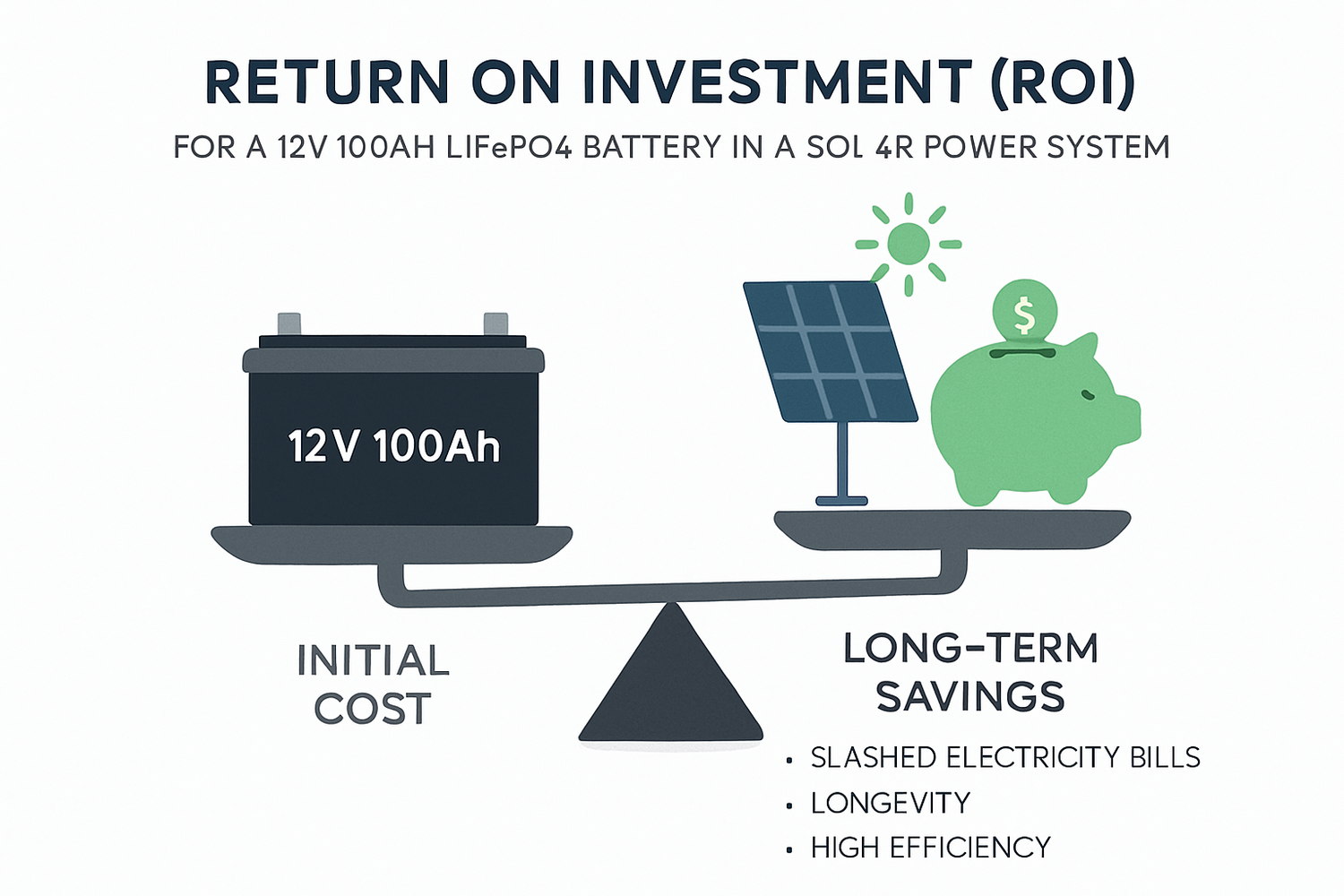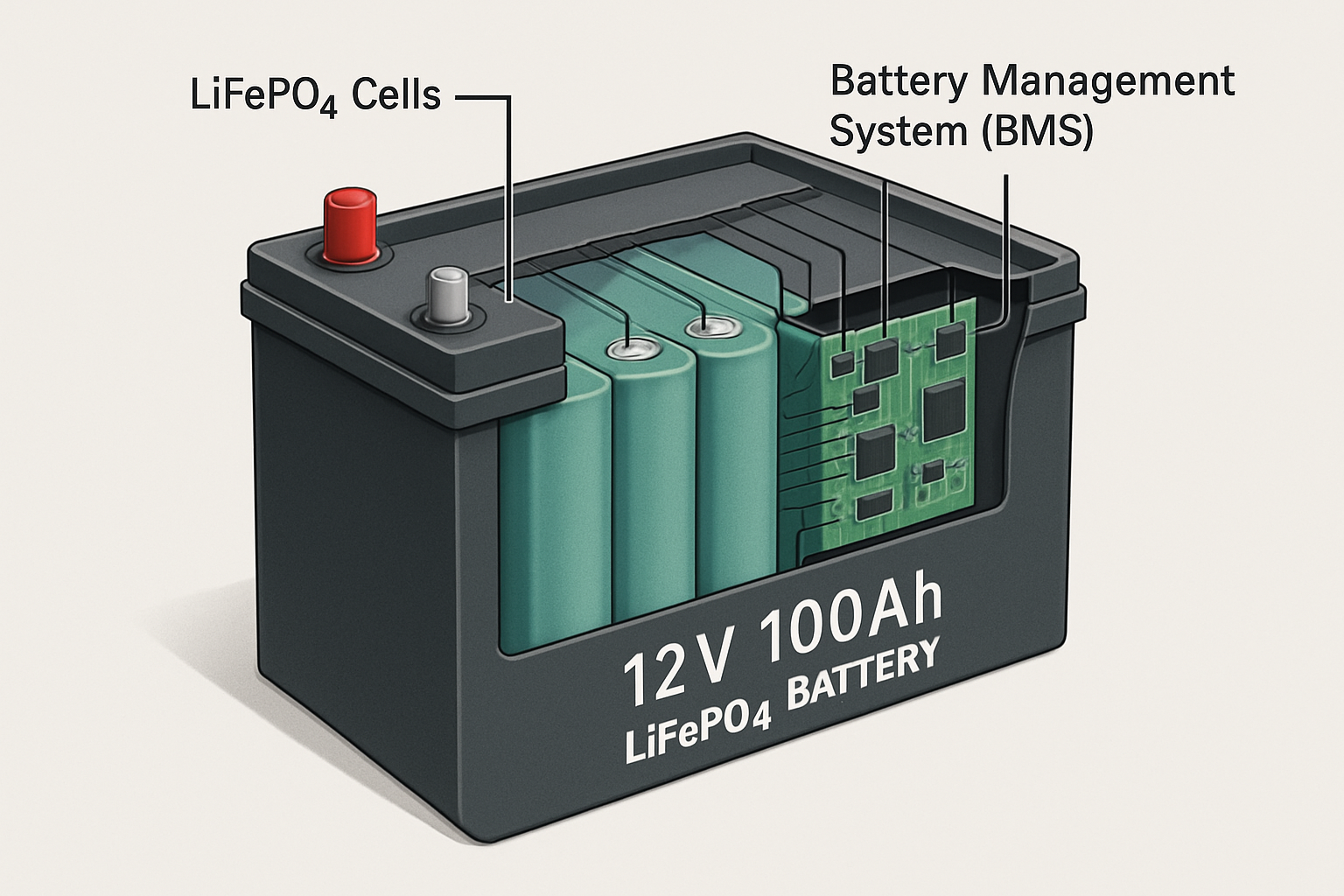Installing a solar panel system is a significant step toward energy independence, but the real game-changer is adding energy storage. A 12V 100Ah LiFePO4 battery is a popular choice for its balance of capacity, longevity, and advanced technology. While the initial price might seem high, its true value is revealed over its lifespan. This analysis breaks down the return on investment (ROI) for a 12V 100Ah LiFePO4 battery, helping you look beyond the upfront cost to see the long-term financial benefits for your solar power setup.
Deconstructing the Upfront Cost of a 12V 100Ah LiFePO4 Battery
Understanding the total initial expense is the first step in evaluating your battery investment return. The cost is more than just the battery itself and requires a comparison with older technologies to appreciate the value proposition.
Beyond the Battery Price Tag
The total upfront cost includes the battery and several other essential components. While most high-quality LiFePO4 batteries have an integrated Battery Management System (BMS), you may also need to account for compatible wiring, fuses, and potentially a new solar charge controller designed to handle the specific charging profiles of lithium batteries. Factoring in these items provides a realistic picture of the initial investment required.
Comparing LiFePO4 to Traditional Lead-Acid Batteries
LiFePO4 batteries have a higher initial purchase price than traditional sealed lead-acid (AGM) or flooded lead-acid batteries. However, the upfront cost is only one part of the equation. A simple comparison reveals significant differences in performance and lifespan that directly impact long-term value.
| Metric | LiFePO4 Battery | AGM Lead-Acid Battery |
|---|---|---|
| Upfront Cost | Higher | Lower |
| Cycle Life | 4,000 - 8,000+ cycles | 300 - 700 cycles |
| Usable Capacity (DoD) | 80-100% | 50% |
| Efficiency | ~95% | ~85% |
| Maintenance | None | None (Flooded requires regular checks) |
Calculating the Long-Term Value: Key ROI Metrics
The true financial return of a 12V 100Ah LiFePO4 battery becomes clear when you analyze its performance over its entire operational life. Key metrics like cycle life, efficiency, and the total cost of ownership paint a much different picture than the initial price.
Cycle Life and Depth of Discharge (DoD)
A battery's cycle life refers to the number of times it can be fully charged and discharged before its capacity degrades significantly. LiFePO4 batteries offer an impressive cycle life, often exceeding 4,000 cycles, while some can last for 10,000 cycles or more under optimal conditions. In contrast, traditional lead-acid batteries may only last for a few hundred cycles. Furthermore, LiFePO4 batteries can be regularly discharged to 80-100% of their capacity without significant damage. Lead-acid batteries should only be discharged to 50% to preserve their lifespan. This means a 100Ah LiFePO4 battery provides nearly double the usable energy of a 100Ah lead-acid battery, reducing the number of batteries and replacements needed over time.
Energy Efficiency and Reduced Waste
Round-trip efficiency measures how much energy is returned from the battery compared to the amount put in. LiFePO4 batteries boast a high efficiency of around 95%. This means that for every 100 watts of solar power you put into the battery, you get about 95 watts back. Lead-acid batteries are less efficient, at around 80-85%, meaning more of your valuable solar energy is lost as heat during the charging and discharging process. Higher efficiency translates directly into lower energy waste and more stored power available for your use.
The Levelized Cost of Storage (LCOS)
A more advanced way to measure the true cost is the Levelized Cost of Storage (LCOS). This metric calculates the cost per kilowatt-hour (kWh) of energy the battery will deliver over its lifetime. The simplified formula is: LCOS = Total Lifetime Cost / Total Lifetime Energy Output. Although the initial cost of a LiFePO4 battery is higher, its long cycle life, high depth of discharge, and superior efficiency result in a significantly lower LCOS compared to lead-acid alternatives. This makes it a more economical choice over the long term.
Tangible Savings and Financial Benefits
Investing in a 12V 100Ah LiFePO4 battery generates returns in several ways, from direct monetary savings to the invaluable benefit of energy security.
Slashing Your Electricity Bills
The most direct financial return comes from reducing your reliance on the electrical grid. By storing excess solar energy generated during the day, you can power your home at night or during cloudy periods instead of purchasing expensive electricity from your utility. In areas with Time-of-Use (TOU) rates, you can maximize savings by using stored energy during peak-rate hours when grid electricity is most expensive.
Achieving Energy Independence and Reliability
A solar battery provides a reliable backup power source during grid outages. This energy security is a significant, though not always monetary, return. For off-grid systems in RVs, cabins, or remote homes, a LiFePO4 battery is a cornerstone of reliable, independent power. Its stability and long life make it a dependable energy solution where the grid is not an option.
The Impact of Evolving Energy Policies
Global investment in clean energy is on the rise, driven by supportive government policies and long-term cost reductions. According to a report from the International Energy Agency, the World Energy Investment 2023, policy support like the Inflation Reduction Act in the United States is accelerating the adoption of technologies including battery storage. This trend suggests a favorable environment for solar investments, potentially leading to more incentives that can further improve your battery investment return.
Best Practices for a Higher ROI
To get the most out of your investment, it is important to design your system correctly and follow best practices for operation and maintenance.
Proper System Sizing and Integration
Maximizing your ROI starts with a properly sized system. An undersized battery will not meet your energy needs, while an oversized one means you have paid for capacity you do not use. Your 12V 100Ah LiFePO4 battery system should be balanced with your solar array's generation capacity and your typical energy consumption to ensure optimal performance and financial return.
Smart Monitoring and Maintenance
LiFePO4 batteries are virtually maintenance-free, a significant advantage over flooded lead-acid types. However, monitoring the system is key to longevity. The integrated BMS protects the battery from overcharging, deep discharging, and extreme temperatures. For a comprehensive look at optimizing your system, understanding key performance indicators is crucial. You can find an in-depth analysis of solar storage performance metrics that explains how to get the most out of your setup.A report by the IEA, the Energy Technology Perspectives 2024, highlights how manufacturing costs are influenced by factors like access to finance and raw materials, underscoring the value of choosing a high-quality battery with a robust BMS to protect your investment.
Is a 12V 100Ah LiFePO4 Battery a Smart Financial Move?
When you look past the initial price, the financial case for a 12V 100Ah LiFePO4 battery becomes compelling. Its superior cycle life, higher usable capacity, greater efficiency, and maintenance-free operation contribute to a lower total cost of ownership and a stronger battery investment return. The investment is not just about saving money on electricity bills; it is about securing a reliable, long-term energy solution that provides independence and peace of mind. For many solar power applications, it represents a smart financial move toward a more resilient energy future.
Disclaimer: The financial calculations and projections in this guide are for illustrative purposes. Consult with a qualified financial advisor and a professional solar installer to evaluate your specific situation.
Frequently Asked Questions
How long does it take to see a return on a LiFePO4 battery?
The payback period for a LiFePO4 battery varies based on factors like local electricity rates, your energy consumption, and the amount of solar energy you generate. Typically, the payback period can range from 7 to 10 years, but the battery's operational life of 10-15 years or more ensures savings continue long after the initial cost is recovered.
Is a single 12V 100Ah LiFePO4 battery powerful enough for a home?
A single 12V 100Ah battery is excellent for smaller applications like RVs, boats, or powering specific circuits in a small off-grid cabin. For a typical residential home, you would need to connect multiple batteries in series and/or parallel to create a larger energy storage system with sufficient capacity to meet household energy demands.
What is the main advantage of LiFePO4 over other lithium batteries for solar ROI?
The primary advantages of LiFePO4 chemistry are its exceptional safety and very long cycle life. LiFePO4 is thermally stable and has a much lower risk of thermal runaway compared to other lithium-ion chemistries. Its ability to endure thousands of charge-discharge cycles means the long-term cost per kWh stored is extremely low, which is the most critical factor for achieving a strong return on investment in a solar storage system.





Leave a comment
All comments are moderated before being published.
This site is protected by hCaptcha and the hCaptcha Privacy Policy and Terms of Service apply.